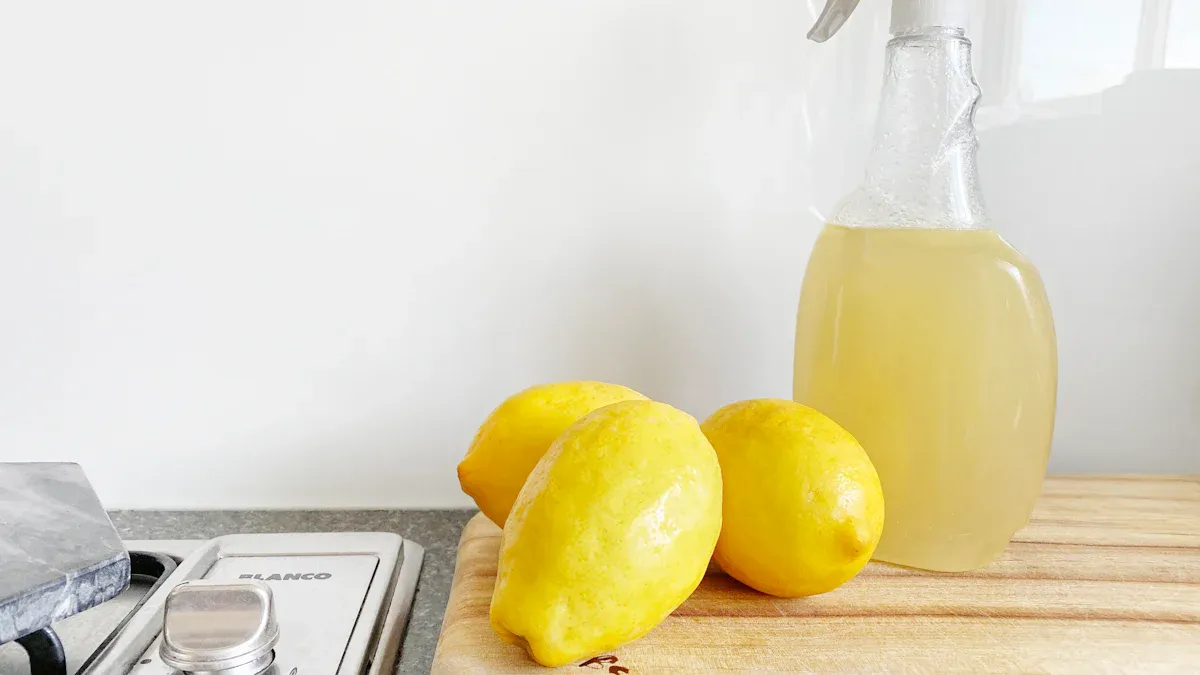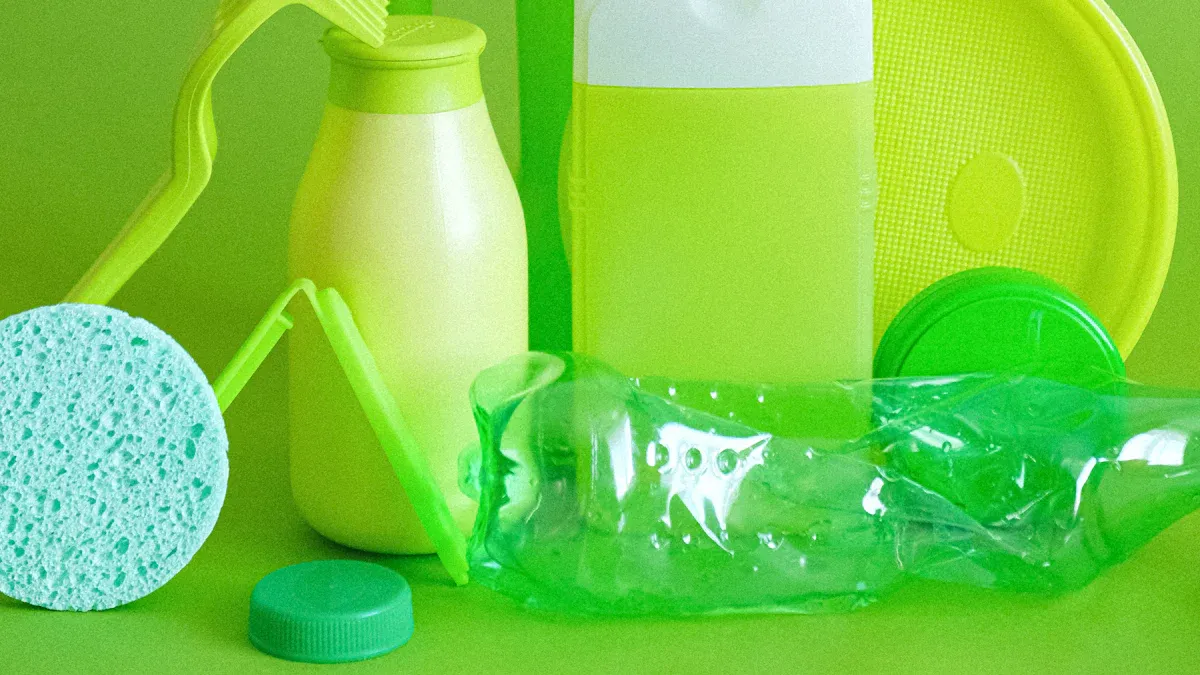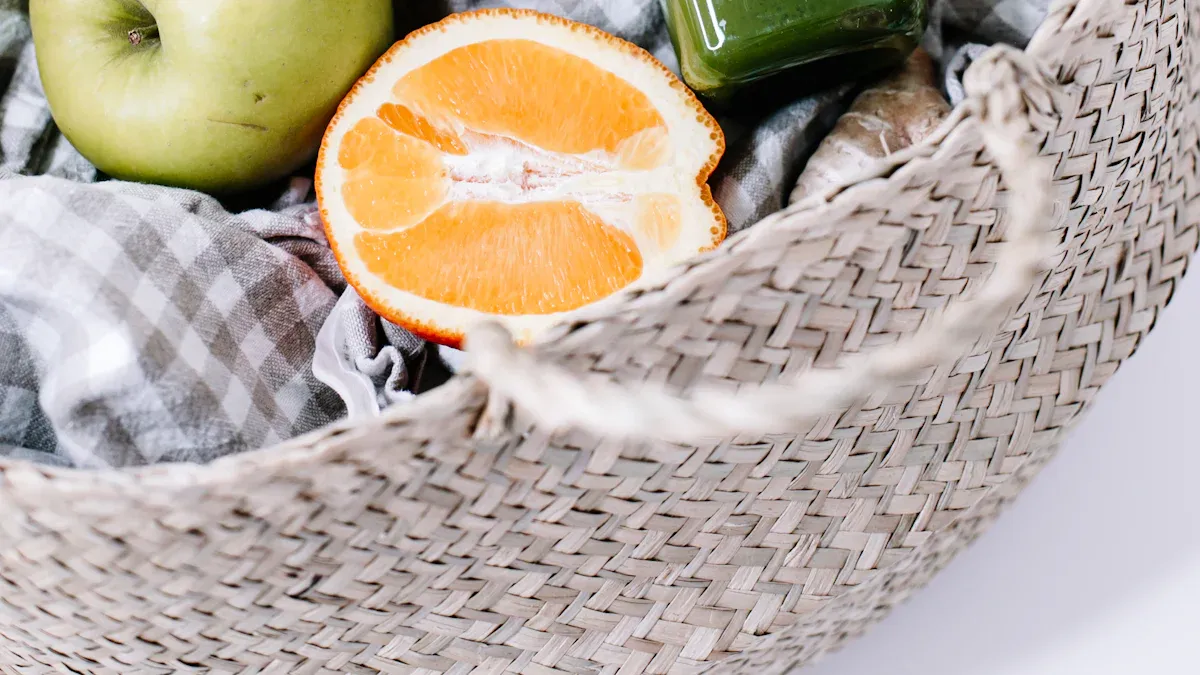Practical Ways to Detoxify Your Living Space for Better Health

Your home should be a sanctuary, but hidden toxins can silently harm your health. Environmental pollutants, like volatile organic compounds (VOCs) and synthetic fragrances, can trigger allergies or even long-term illnesses. Did you know that fine particulate air pollution causes about 100,000 premature deaths annually in the U.S.? Globally, toxins contributed to 8.3 million deaths in 2017. Detox your living space: environmental toxins and your health are closely linked. A toxin-free home improves air quality, reduces chemical exposure, and helps you feel your best every day.
Key Takeaways
Find common toxins like VOCs and fake scents at home. Knowing them helps you avoid them and stay healthier.
Make air inside better by letting fresh air in. Open windows often and use fans to remove bad air.
Use natural cleaners instead of chemical ones. Mix vinegar and baking soda to clean safely without harmful stuff.
Clean your water and pick safe pots and pans. Drinking clean water and cooking safely are important for good health.
Use less plastic by choosing reusable things. Simple swaps like cloth bags and beeswax wraps cut down on trash.
Detox Your Living Space: Environmental Toxins and Your Health
Identify Common Household Toxins
Your home might look clean, but hidden toxins could be lurking in everyday items. Let’s uncover some of the most common offenders:
VOCs from paints, furniture, and cleaning products
Volatile Organic Compounds (VOCs) are chemicals released into the air from products like paints, furniture, and even cleaning supplies. These invisible pollutants can cause headaches, dizziness, and long-term respiratory issues.
Synthetic fragrances and air fresheners
That lavender-scented air freshener? It might smell great, but synthetic fragrances often contain phthalates, which can disrupt hormones and trigger allergies. Opt for natural alternatives to keep your air fresh and safe.
Mold, dust, and other allergens
Mold thrives in damp areas like bathrooms and basements, while dust mites love your carpets and bedding. Both can worsen asthma and allergies, especially in children. Regular cleaning and dehumidifiers can help keep these allergens under control.
Here’s a quick look at some common household toxins and their health risks:
Chemical Class | Description | Health Risks |
|---|---|---|
Phthalates | Found in cosmetics, toys, and vinyl flooring. | Linked to hormone interference, declines in IQ, and respiratory problems in children. |
Flame Retardants | Commonly found in furniture and baby products. | Associated with cancer risks, including TDCIPP, a known carcinogen. |
Highly Fluorinated Chemicals | Present in non-stick cookware and various consumer products. | Linked to immune, digestive, developmental, and endocrine system issues. |
Volatile Organic Compounds (VOCs) | Released from cleaning products and household items. | Contributes to respiratory problems, allergic reactions, and headaches. |
Phenols | Used in cleaning products and other household items. | Can cause irritation and other health issues. |
Understand the Health Impacts
The toxins in your home don’t just sit there—they can seriously affect your health.
Respiratory issues, allergies, and skin irritation
Exposure to VOCs, mold, and synthetic chemicals can lead to breathing problems, itchy skin, and watery eyes. According to the Global Alliance on Health and Pollution, household air pollution contributes to respiratory infections and lung cancer, causing 100,000 premature deaths annually in the U.S.
Long-term exposure risks, such as hormonal disruption or chronic illnesses
The dangers don’t stop there. Long-term exposure to toxins like phthalates and flame retardants can disrupt hormones, impair growth, and even increase cancer risks. For example, dioxins are linked to cancer, while lead exposure—like in the Flint water crisis—causes neurotoxic effects.
Here’s a snapshot of how household toxins impact health over time:
Toxin | Health Impact | Percentage of Deaths |
|---|---|---|
Ischaemic heart disease | 12% of all deaths due to ischaemic heart disease attributed to household air pollution | 32% |
Stroke | 12% of all deaths due to stroke attributed to household air pollution | 23% |
Lower respiratory infection | Almost doubles the risk for childhood LRI; responsible for 44% of pneumonia deaths in children under 5 | 21% |
Chronic obstructive pulmonary disease (COPD) | 23% of all deaths from COPD in adults in low- and middle-income countries attributed to household air pollution | 19% |
Lung cancer | 11% of lung cancer deaths in adults attributed to household air pollution | 6% |
By identifying and addressing these toxins, you can take the first step toward creating a healthier home. Detox your living space: environmental toxins and your health are more connected than you might think.
Improve Indoor Air Quality

Improving the air quality in your home is one of the easiest ways to boost your health. Breathing clean air reduces the risk of allergies, respiratory issues, and even long-term illnesses. Let’s explore some practical steps you can take.
Increase Ventilation
Fresh air is your best friend when it comes to detoxifying your living space.
Open windows daily: Even just 10-15 minutes of fresh air circulation can make a big difference. It helps flush out indoor pollutants like VOCs and stale air.
Use exhaust fans: Kitchens and bathrooms are hotspots for moisture and odors. Exhaust fans help reduce humidity, preventing mold growth and keeping the air fresh.
Use Air Purifiers
Sometimes, opening windows isn’t enough, especially if you live in a polluted area. That’s where air purifiers come in.
Choose HEPA air purifiers: These are excellent for filtering out allergens like dust, pet dander, and pollen. They’re a lifesaver if you or your family members have allergies.
Opt for activated carbon filters: These filters go a step further by absorbing harmful chemicals and odors. They’re perfect for tackling VOCs from cleaning products or furniture.
Add Air-Purifying Plants
Did you know some plants can naturally clean the air? Adding greenery to your home not only improves air quality but also creates a calming atmosphere.
Incorporate plants like aloe vera, peace lilies, or spider plants: These plants are known for their air-purifying abilities. Plus, they’re easy to care for!
Avoid overwatering: Too much water can lead to mold growth, which defeats the purpose of having plants for cleaner air.
By taking these steps, you’ll create a healthier environment for yourself and your loved ones. Detox your living space: environmental toxins and your health are deeply connected, and improving air quality is a great place to start.
Reduce Chemical Exposure
Reducing chemical exposure in your home is easier than you might think. By making a few simple swaps, you can create a safer, healthier environment for yourself and your family.
Switch to Natural Cleaning Products
The cleaning products you use can have a big impact on your indoor air quality. Many conventional cleaners contain harsh chemicals that can irritate your skin, eyes, and lungs.
Use DIY cleaners: You can make your own cleaning solutions using everyday items like vinegar, baking soda, and essential oils. For example, mix equal parts vinegar and water for an all-purpose cleaner. Add a few drops of lemon or tea tree oil for a fresh scent.
Choose eco-friendly brands: If DIY isn’t your thing, look for non-toxic cleaning products from trusted eco-friendly brands. These products are free from harmful chemicals and safe for both your family and the environment.
Tip: Switching to natural cleaners not only reduces toxins but also saves money in the long run.
Replace Synthetic Fragrances
Synthetic fragrances might smell nice, but they often contain harmful chemicals like phthalates, which can disrupt hormones.
Use essential oil diffusers: Essential oils like lavender or eucalyptus provide a natural and safe way to scent your home. Diffusers are easy to use and can even double as humidifiers.
Opt for fragrance-free products: Many personal care items, like lotions and shampoos, are loaded with synthetic fragrances. Choose fragrance-free or naturally scented options to minimize your exposure to unnecessary chemicals.
Avoid Harmful Household Items
Some everyday items in your home might be doing more harm than good.
Replace antibacterial soaps: These soaps often contain triclosan, a chemical linked to hormone disruption. Switch to natural alternatives made with plant-based ingredients.
Avoid bleached products: Bleached paper towels, napkins, and even coffee filters can release harmful dioxins. Opt for unbleached or natural materials instead.
By making these changes, you’ll significantly reduce the number of harmful chemicals in your home. Detox Your Living Space: Environmental Toxins and Your Health is a journey, and every small step counts toward creating a safer, healthier environment.
Ensure Safer Water and Food Practices
Keeping your water and food safe is essential for a toxin-free home. Let’s dive into some simple ways you can make healthier choices.
Filter Your Water
Clean water is a must for your health. Unfortunately, tap water can contain contaminants like chlorine, lead, or pesticides.
Install a high-quality water filtration system: A good filtration system removes harmful substances, leaving you with cleaner, safer water. Look for options like reverse osmosis or activated carbon filters.
Use reusable water bottles with built-in filters: These are perfect for when you’re on the go. They’re convenient and help reduce plastic waste.
Tip: Regularly replace your filters to ensure they work effectively.
Use Non-Toxic Cookware
The cookware you use can impact the safety of your meals. Some materials release harmful chemicals when heated.
Replace nonstick pans: Nonstick coatings like Teflon can release toxic fumes at high temperatures. Switch to safer options like stainless steel, cast iron, or ceramic cookware.
Avoid harmful coatings: Look for cookware labeled as free from PFAS or PFOA. These chemicals are linked to health risks like hormone disruption.
Cooking with cast iron not only avoids toxins but also adds a small amount of iron to your food, which is great for your health!
Store Food Safely
How you store your food matters more than you might think. Plastic containers can leach chemicals into your food, especially when heated.
Use glass or stainless steel containers: These materials are safer and more durable than plastic. Plus, they don’t absorb odors or stains.
Avoid heating food in plastic: Even microwave-safe plastics can release harmful chemicals when exposed to heat. Stick to glass or ceramic for reheating.
Note: Check your containers for BPA-free labels, but remember that even BPA-free plastics aren’t always safe.
By filtering your water, choosing non-toxic cookware, and storing food safely, you’ll take big steps toward a healthier home. Small changes like these can make a huge difference in reducing your exposure to harmful toxins.
Minimize Plastic Use
Plastic is everywhere, but reducing your reliance on it can make a big difference for both your health and the environment. Let’s explore some simple swaps you can make to minimize plastic use in your home.
Opt for Sustainable Alternatives
Small changes in your daily habits can help you cut down on plastic waste.
Replace plastic bags with reusable options: Instead of using single-use plastic bags, try cloth or silicone alternatives. They’re durable, washable, and perfect for groceries or storage.
Use beeswax wraps for food storage: Ditch the plastic wrap and switch to beeswax wraps. These reusable wraps keep your food fresh and are easy to clean. Plus, they’re biodegradable!
Tip: Keep a few reusable bags in your car or purse so you’re always prepared for shopping trips.
Avoid Single-Use Plastics
Single-use plastics are convenient, but they contribute to massive waste. You can easily avoid them with a few smart choices.
Invest in reusable items: Get yourself a set of reusable straws, utensils, and water bottles. Stainless steel or bamboo options are lightweight and long-lasting.
Choose products with minimal packaging: Look for items that come in biodegradable or recyclable packaging. Bulk stores are a great place to shop for essentials without unnecessary plastic.
Did you know? Americans throw away 40 billion plastic utensils every year. Switching to reusable ones can make a huge impact!
By making these changes, you’ll not only reduce plastic waste but also create a healthier, more sustainable home. Every small step counts, and your efforts can inspire others to do the same. 🌱
Create a Toxin-Free Bedroom

Your bedroom is where you recharge, so it’s essential to make it a toxin-free haven. A few simple changes can transform your space into a healthier, more restful environment.
Choose Organic Bedding
The materials you sleep on matter more than you think. Conventional bedding often contains harmful chemicals that can irritate your skin or disrupt your sleep.
Use sheets and pillowcases made from organic cotton or bamboo: These materials are free from pesticides and synthetic chemicals. They’re also softer and more breathable, giving you a better night’s sleep.
Avoid bedding treated with flame retardants or synthetic dyes: Many conventional options are treated with chemicals to meet safety standards. Look for labels that say “chemical-free” or “natural dyes” to ensure you’re making a safe choice.
Tip: Organic bedding might cost more upfront, but it’s a worthwhile investment for your health and comfort.
Invest in a Non-Toxic Mattress
Your mattress could be a hidden source of toxins. Many contain polyurethane foam or chemical flame retardants, which release harmful gases over time.
Look for mattresses made from natural latex, wool, or organic cotton: These materials are naturally hypoallergenic and free from harmful chemicals. They also provide excellent support and durability.
Avoid mattresses with polyurethane foam or chemical flame retardants: Check the label or ask the manufacturer about the materials used. Certifications like GOTS (Global Organic Textile Standard) or GOLS (Global Organic Latex Standard) can help you identify safe options.
Did you know? Natural latex mattresses are not only non-toxic but also resistant to dust mites and mold.
Reduce EMF Exposure
Electromagnetic fields (EMFs) from electronic devices can interfere with your sleep and overall health. Reducing your exposure is easier than you think.
Keep electronic devices out of the bedroom or unplug them at night: This includes phones, tablets, and even alarm clocks. If you need your phone nearby, switch it to airplane mode.
Use a grounding mat to reduce electromagnetic field exposure: These mats help neutralize EMFs and promote better sleep.
Note: A tech-free bedroom isn’t just healthier—it’s also more relaxing.
By making these changes, you’ll create a bedroom that supports your health and well-being. Sweet dreams! 🌙
Detoxifying your living space is one of the best things you can do for your health. Cleaner air, fewer chemicals, and less plastic make a big difference in how you feel every day. Start small. Open your windows, switch to natural cleaners, and add a few air-purifying plants. Replace plastic bags with reusable ones or swap your bedding for organic options. Every step counts. Detox Your Living Space: Environmental Toxins and Your Health isn’t just a goal—it’s a lifestyle. You’ve got this!
FAQ
What are the easiest ways to start detoxifying my home?
Start small! Open your windows daily for fresh air, switch to natural cleaning products, and add a few air-purifying plants. These simple steps make a big difference without feeling overwhelming.
Tip: Focus on one room at a time to keep things manageable.
How do I know if my home has VOCs?
VOCs often come from paints, furniture, and cleaning products. If you notice strong chemical smells or experience headaches, dizziness, or irritation, VOCs might be present.
Note: Use low-VOC or VOC-free products to reduce exposure.
Are air-purifying plants safe for pets?
Not all plants are pet-friendly. Spider plants and bamboo palms are safe options. Avoid peace lilies or aloe vera if you have cats or dogs, as they can be toxic when ingested.
Did you know? NASA’s Clean Air Study lists pet-safe plants that purify air.
Can I really make my own cleaning products?
Absolutely! DIY cleaners are simple and effective. Mix vinegar, water, and essential oils for an all-purpose spray. Baking soda works wonders for scrubbing tough stains.
Bonus: DIY cleaners save money and reduce chemical exposure.
How often should I replace air purifier filters?
Check your air purifier’s manual, but most filters need replacing every 6-12 months. HEPA filters last longer, while activated carbon filters may need more frequent changes.
Pro Tip: Set a reminder on your phone to stay on schedule.
See Also
Join Us at Banish Cancer – A Place of Hope
Exploring Lymphomatoid Granulomatosis: Symptoms and Treatment Options
Conjunctival Melanoma: Key Symptoms and Available Treatments
Endodermal Sinus Tumors: Symptoms and Diagnostic Insights
Duodenal Cancer: Recognizing Symptoms and Treatment Approaches
